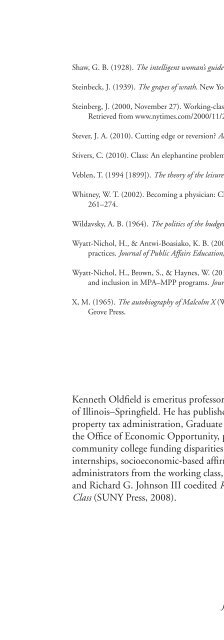WINTER 2012 - National Association of Schools of Public Affairs and ...
WINTER 2012 - National Association of Schools of Public Affairs and ...
WINTER 2012 - National Association of Schools of Public Affairs and ...
You also want an ePaper? Increase the reach of your titles
YUMPU automatically turns print PDFs into web optimized ePapers that Google loves.
Gary L. Wamsley<br />
If anyone does not underst<strong>and</strong> the metaphor, they probably have never seen<br />
sparrows in a barnyard picking tiny pieces <strong>of</strong> oats from horse manure. The<br />
Reagan administration was, to say the least, not pleased with Stockman’s<br />
characterization, notwithst<strong>and</strong>ing its accuracy.<br />
Seventh, I would return to the assignment where students marked the<br />
vertical <strong>and</strong> horizontal lines indicating their parents’ wealth <strong>and</strong> their own<br />
political leanings. After reviewing their answers, I would replicate the recent<br />
study by Norton <strong>and</strong> Ariely (2011), whose results give reason for both<br />
despair <strong>and</strong> hope. In particular, these researchers assembled a nationally<br />
representative panel <strong>of</strong> Americans <strong>and</strong> showed them pie charts depicting the<br />
percentage distribution <strong>of</strong> wealth (everything one owns minus all debts) in<br />
three unidentified political systems (United States, Sweden, <strong>and</strong> a fictional<br />
state). The pie charts were divided into five groups, each representing 20% <strong>of</strong><br />
the country’s population along with the proportion <strong>of</strong> wealth owned by the<br />
respective quintiles. The distribution in the fictional state was evenly divided so<br />
that each group held 20% <strong>of</strong> that nation’s wealth. The Swedish chart showed<br />
that that country’s top quintile holds 36% <strong>of</strong> the wealth, 3 <strong>and</strong> the other quintiles<br />
possess these amounts in descending order: 21%, 18%, 15%, <strong>and</strong> 11%. The<br />
unidentified U.S. chart showed the top fifth <strong>of</strong> the population owning 84% <strong>of</strong><br />
the wealth, while the second quintile held 11%, the third 4%, the fourth 0.2%,<br />
<strong>and</strong> the bottom quintile 0.1%.<br />
Respondents were given a “Rawls (1971) constraint” for determining a just<br />
society: “In considering this question, imagine that if you joined this nation, you<br />
would be r<strong>and</strong>omly assigned to a place in the distribution, so you could end up<br />
anywhere in this distribution, from the very richest to the very poorest” (Norton<br />
& Ariely, 2011, p. 10, quoting Rawls). The U.S. distribution was considered<br />
far less desirable than Sweden’s or the fictional state with its equal divisions.<br />
Ninety-two percent <strong>of</strong> those questioned preferred Sweden’s distribution to America’s.<br />
These results held for respondents when controlling for gender, political party,<br />
<strong>and</strong> income. There was a slight preference for the Swedish distribution over the<br />
unnamed state’s equal distribution, suggesting Americans favor some inequality<br />
versus absolute equality, but certainly not as much variation as currently exists in<br />
the United States.<br />
If the outcome <strong>of</strong> the in-class replication <strong>of</strong> Ariely <strong>and</strong> Norton’s study<br />
is anything like what they found, the results will give students a better<br />
underst<strong>and</strong>ing <strong>of</strong> the extremes <strong>of</strong> America’s maldistribution <strong>of</strong> wealth. I<br />
would also point out to students that existing inheritance laws, college legacy<br />
preferences, <strong>and</strong> so forth will likely intensify these current disparities. Hopefully,<br />
after completing this exercise, these same students will entertain, at least in the<br />
abstract, a discussion about policies directed toward a downward redistribution<br />
<strong>of</strong> wealth. Indeed, the people participating in Ariely <strong>and</strong> Norton’s study<br />
supported the idea <strong>of</strong> sharing wealth more equally. However, the basic problem,<br />
102 Journal <strong>of</strong> <strong>Public</strong> <strong>Affairs</strong> Education

















